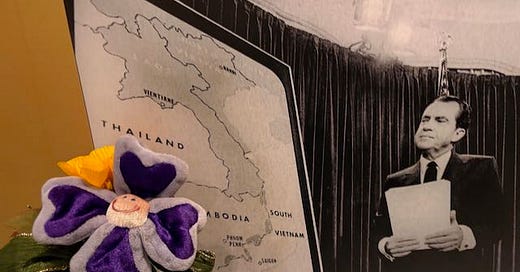Visiting Vietnam's War Remnants Museum with Flowers
Despite U.S. Student Protests in 1970, It Still Took Five More Years to Bring Peace in Vietnam
Our esteemed traveling bouquet ‘Flowers’ pays homage to peace in a visit to the War Remnants Museum in Ho Chi Minh City. Flowers brings a special interest in and remembrance of President Richard Nixon’s April 30, 1970 speech and planned invasion of Cambodia, a sovereign nation bordering Vietnam.
Vietnam’s War Remnants Museum was established just five months after the fall of Saigon signaling the end of the American war in Vietnam. From their website: “Founded on September 4, 1975, The War Remnants Museum is a member of the International Network of Museums for Peace (INMP) and the International Council of Museums (ICOM).”
Flowers begins her tour at the thematic exhibit of a U.S. army soldier holding his rifle in front of a burning village in the jungles of Vietnam. Also housed is an exhibit on War Crimes revealing “the lingering consequences of the atrocities committed by the U.S. during its war of aggression against Vietnam.” The exhibit illustrates how “forces trampled on these principles as well as international laws by systematically capturing, torturing, raping, and killing civilian populations and prisoners of war, and even perpetrating massacres like the killing of 504 civilians in Son My, Quang Ngai, in 1968.”
Other Museum exhibits explore Agent Orange, Historical Truths and the Consequences of Agent Orange. Flowers appreciates how this Museum wishes to teach all to never participate in war crimes, expose a population to Agent Orange and all the other atrocities brought with U.S. aggression.
Flowers recollects President Nixon’s April 30, 1970 speech before the nation on his expansion of the Vietnam war in the Cambodian invasion. Trouble was, Nixon’s 1970 announcement about expanding into Cambodia wasn’t really news. For over a year, underground sources reported the bombing of Cambodia and Laos before Nixon finally came clean to the U.S. public … and the bombing continued for three more years.
Nixon’s April 30, 1970 words were an about-face and to many in the peace movement, felt like a slap in the face. The betrayal stung. In May 1970 student protests on campuses across America swelled as they defiantly responded to the President’s decisions. First casualties were ROTC quarters on many U.S. campuses; Student protesters were burning them to the ground.
U.S. citizens and student protesters against the American war in Vietnam and the Cambodian invasion gathered to watch the President’s speech on April 30, 1970. Initial responses were angry protests against the President’s invasion of Cambodia yet across America peaceful citizens and students also remembered Nixon’s broken promise. In 1968, Nixon ran for President on his “secret plan,” promising peace in Vietnam and a swift end to the war … not an expansion of the war.
Even though students and antiwar protesters across Americans protested in their opposition to President Nixon’s invasion of Cambodia and expansion of the Vietnam war, American leadership refused to listen or care. It was clear the U.S. military had a war to fight and continue at all costs, so instead responding to mass protests they focused on new schemes to target student protesters against war. With an assist from the CIA and COINTELPRO in spying on and harassing young people in 1970, the New Left and Operation CHAOS went into high gear.
On May 4, 1970 and May 15, 1970 unarmed Kent State and Jackson State protesters against war essentially faced firing squads, resulting in the killing of six U.S. antiwar student protesters. More than four million student protesters rose up in dissent across 900 university campuses generating the largest nationwide student protest in U.S. history.
Taking all this into account so many decades later in May 2025, it’s impossible to understand how U.S. leadership got away with keeping the war going five more years. Despite the State killing student protesters against war in historic, extrajudicial massacres, the war machine was undaunted, refusing to abandon Vietnam — Then finally bringing an end to the war on April 30, 1975.
Flowers applauds the War Remnants Museum and its mission: “It is the unique museum in Vietnam to systematically study, collect, conserve and display exhibits on war crimes and consequences inflicted on the Vietnamese people by foreign aggressive forces. Simultaneously, the Museum appeals to everybody to oppose unjust wars, preserve global peace, promote friendship and solidarity among nations.”











In this, the 50th year of the so-called end of the American War- Vietnam continues to remind their people and anyone listening that the costs of war are far too dear to risk again. Trouble is, the Empire thrives on conflict- especially that overseas. And always puts the onus on the 'other'. The Vietnamese people proved that a popular war (theirs) can never be 'won' no matter how powerful the aggressor.
Never forget!